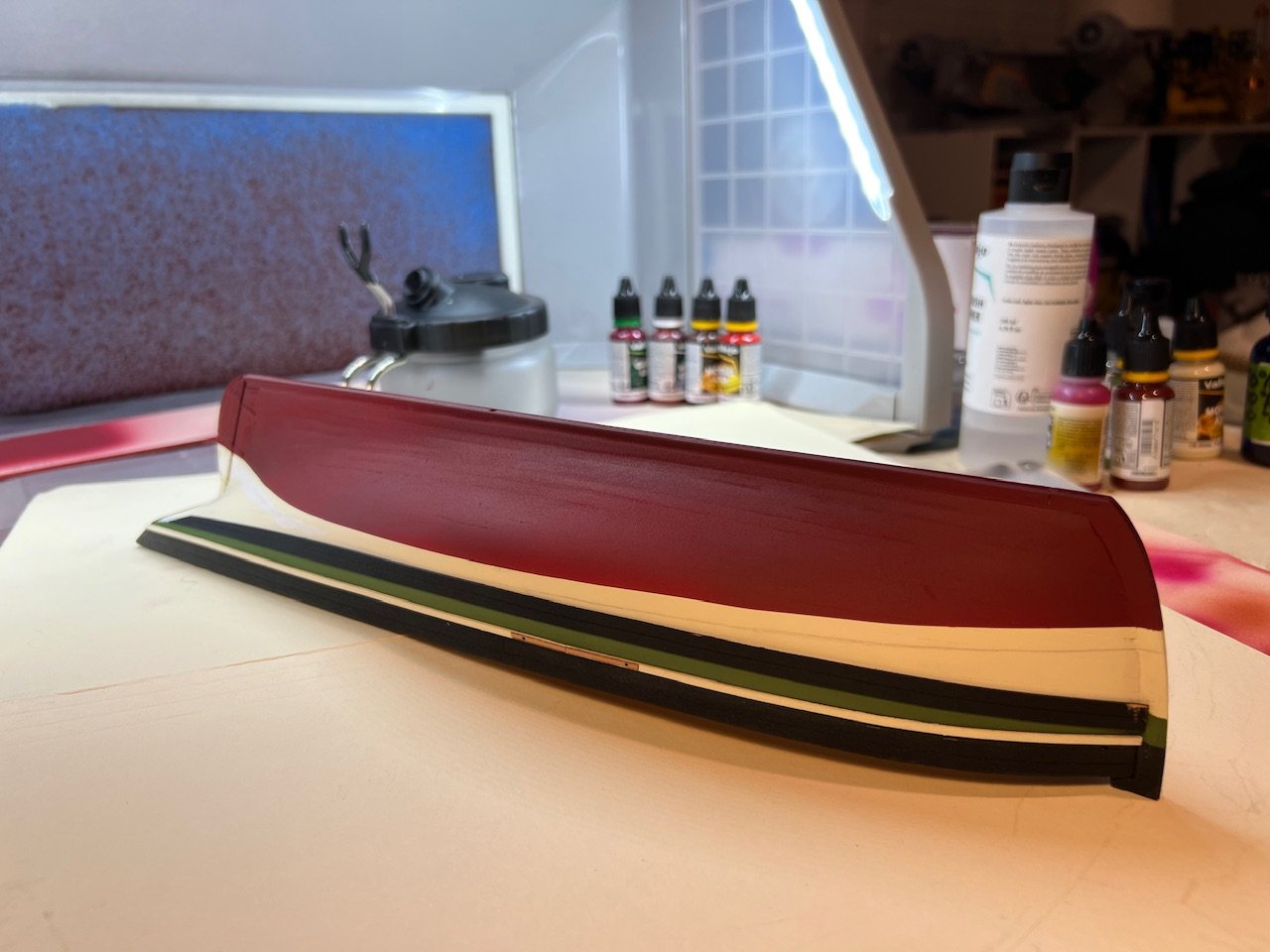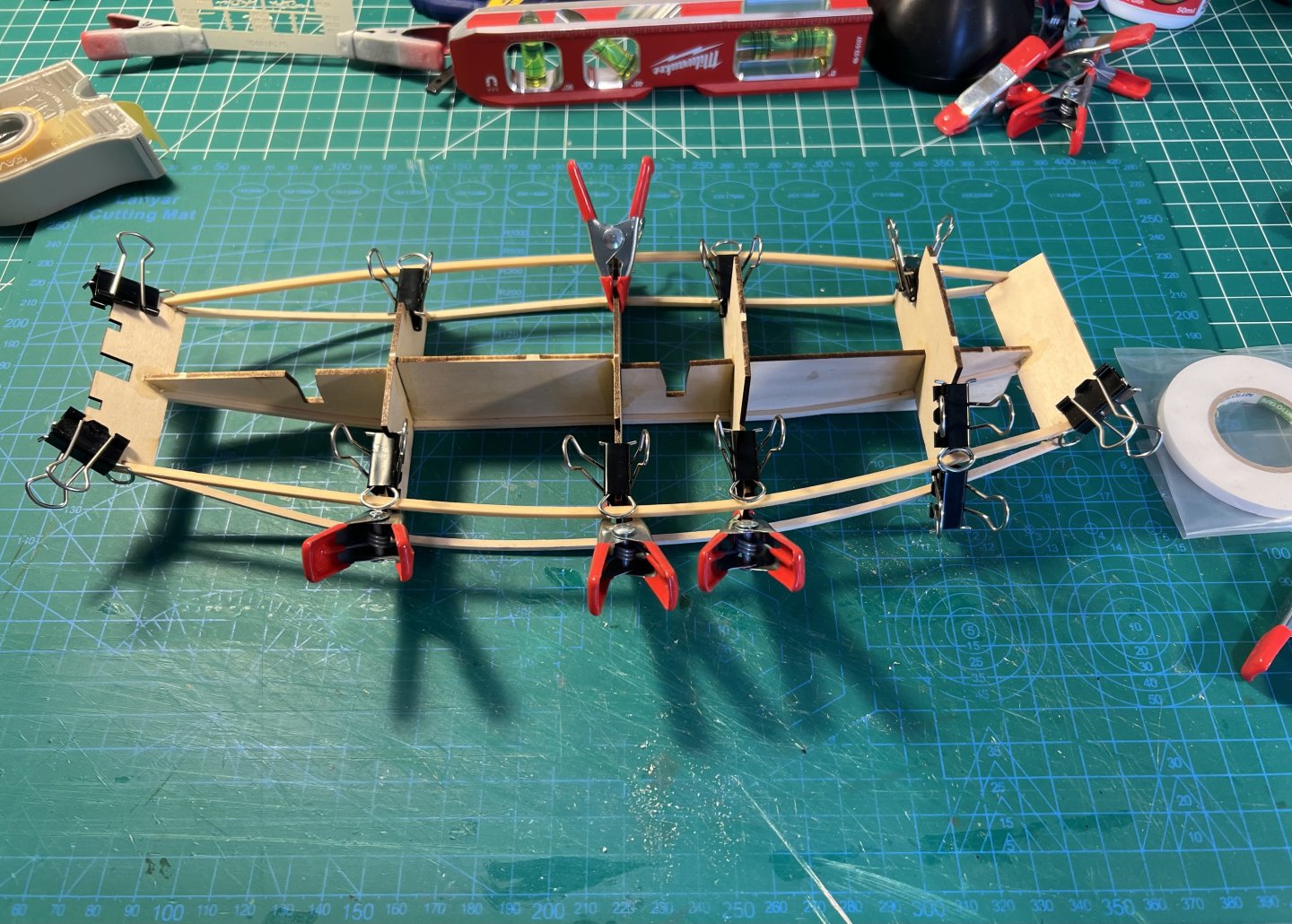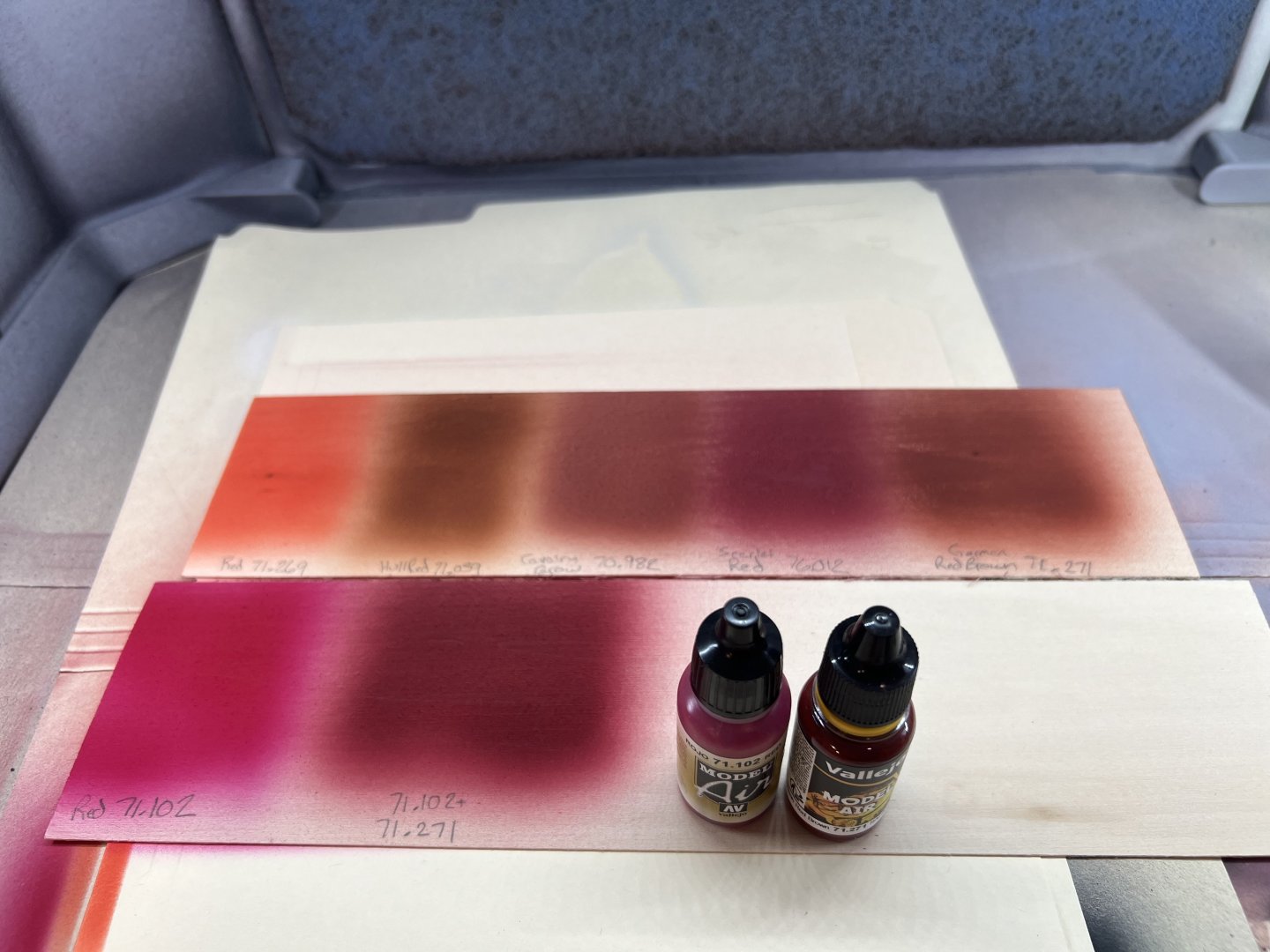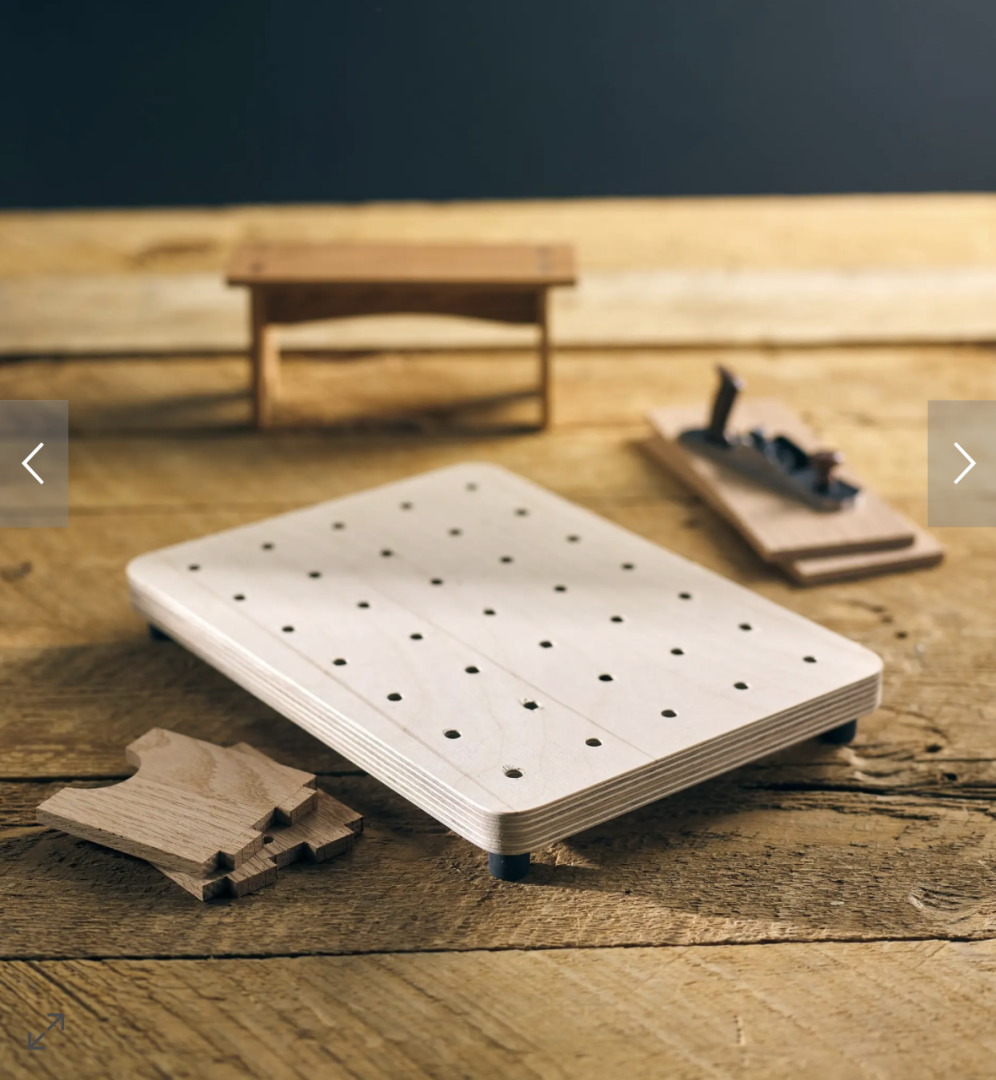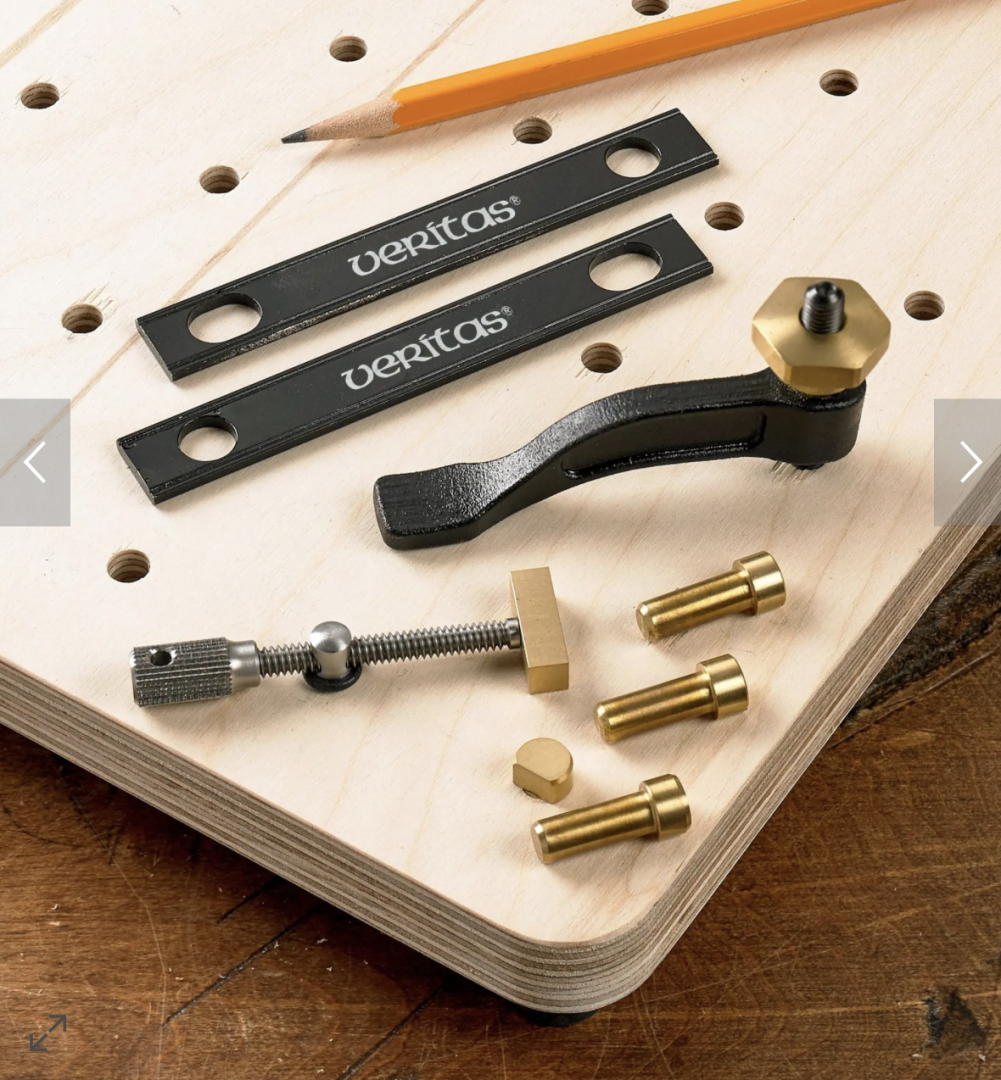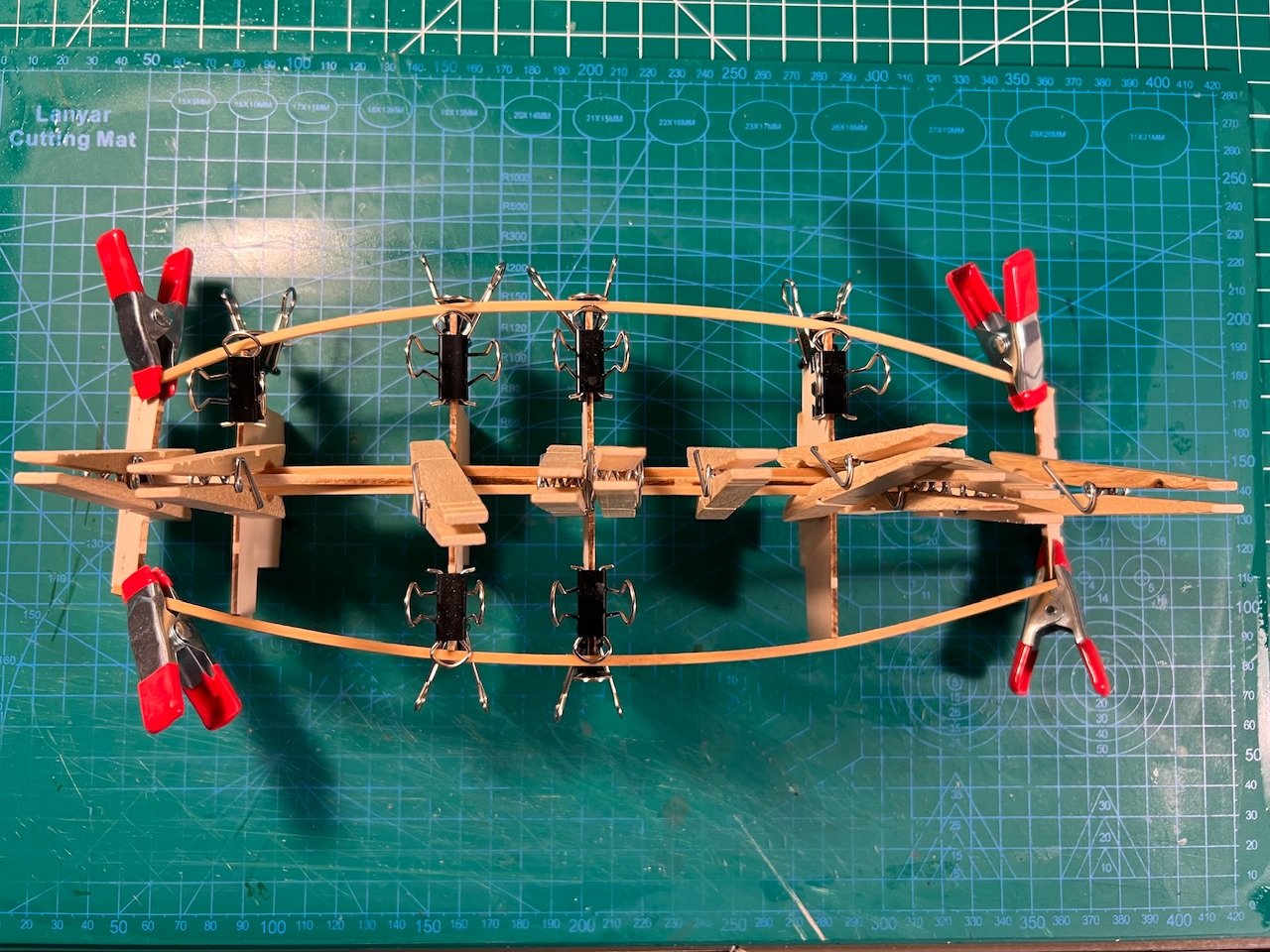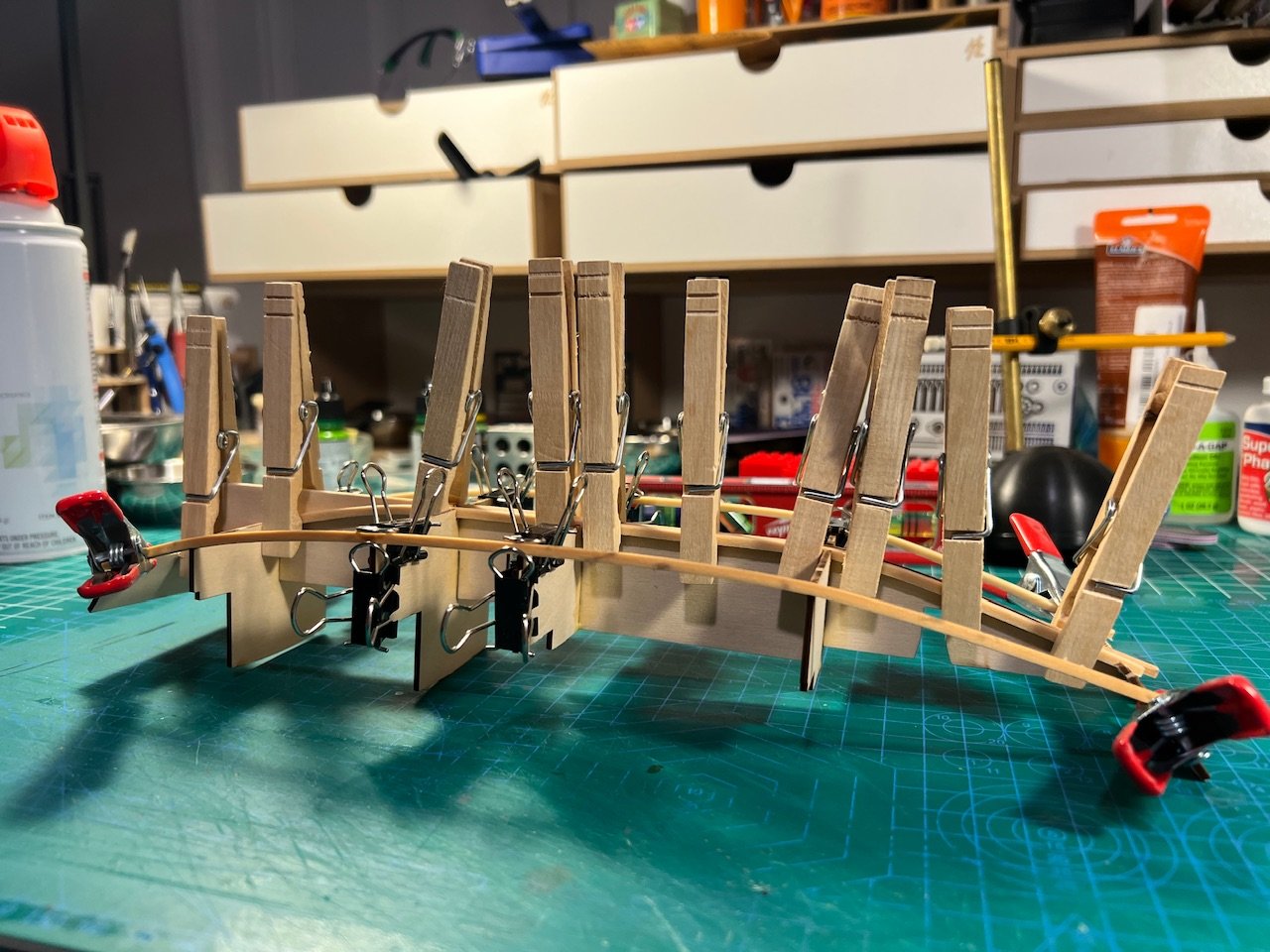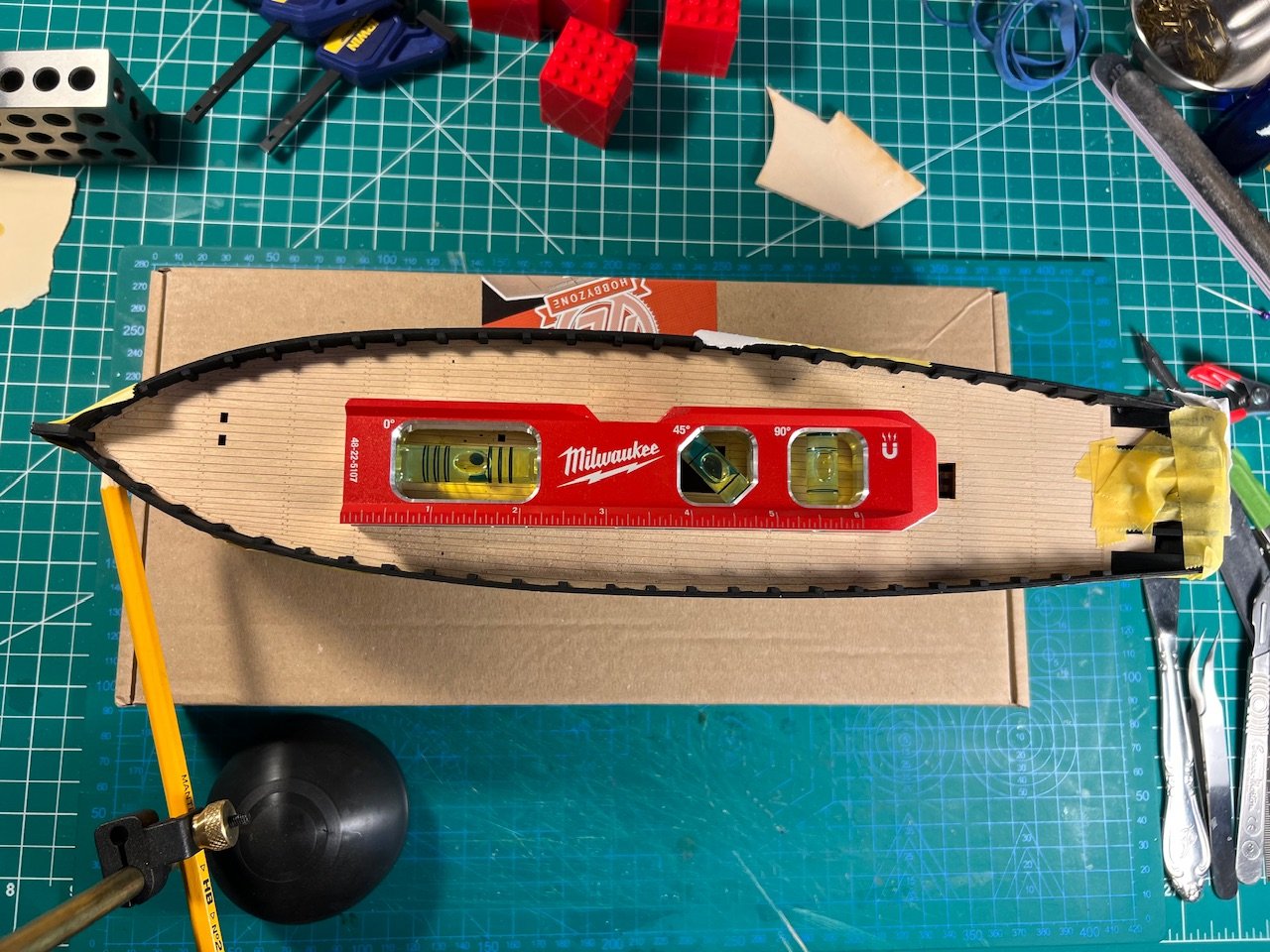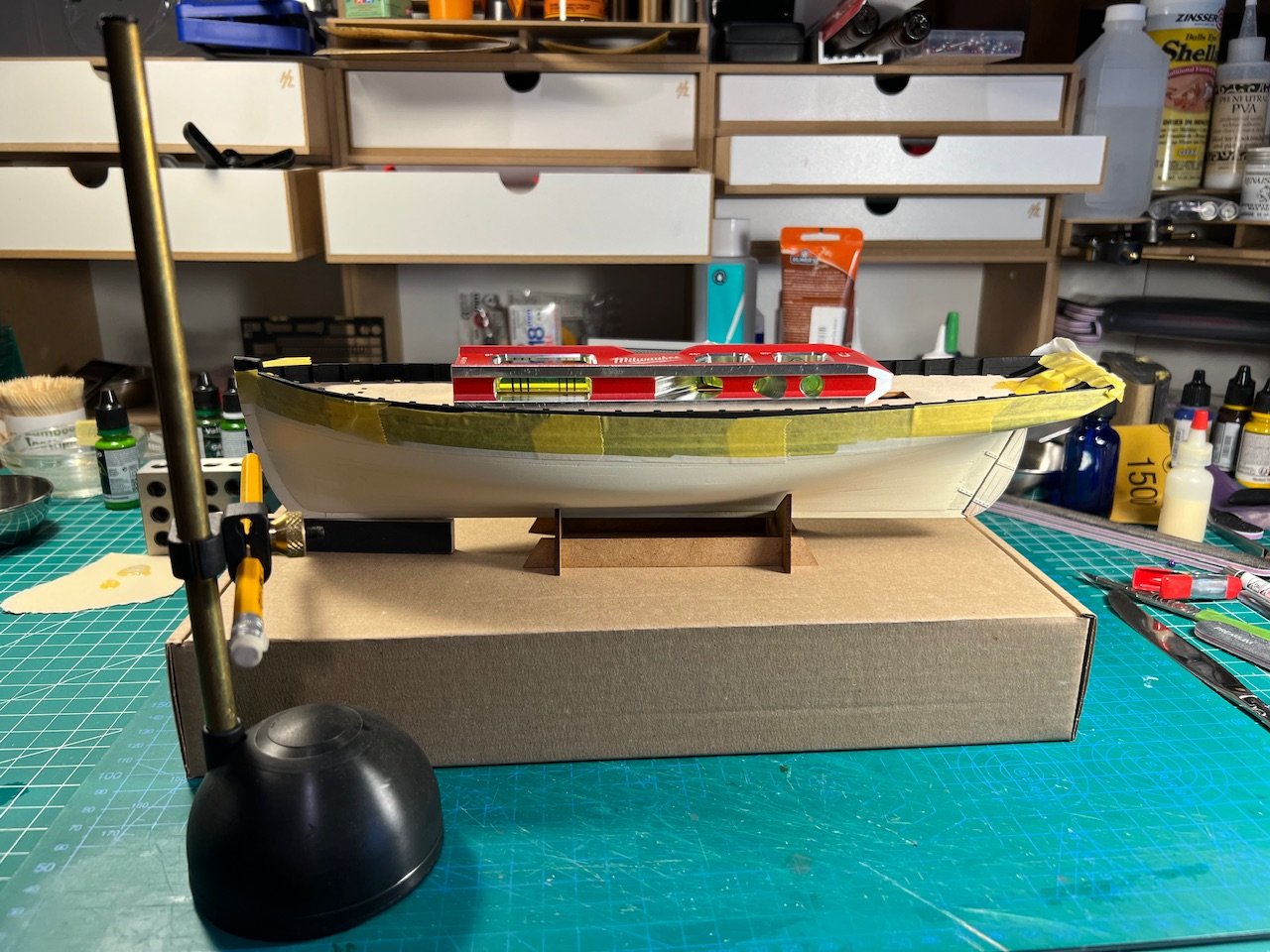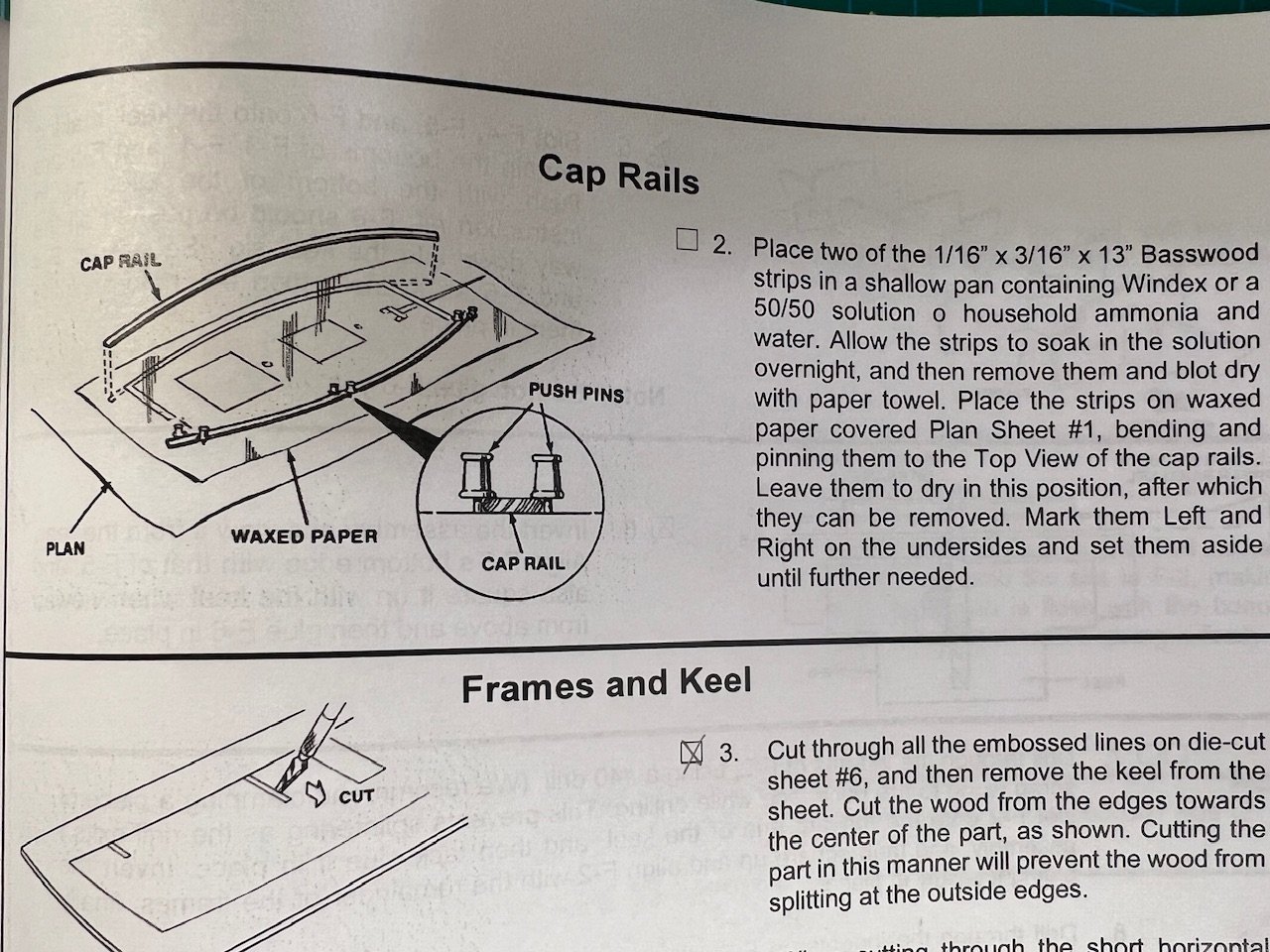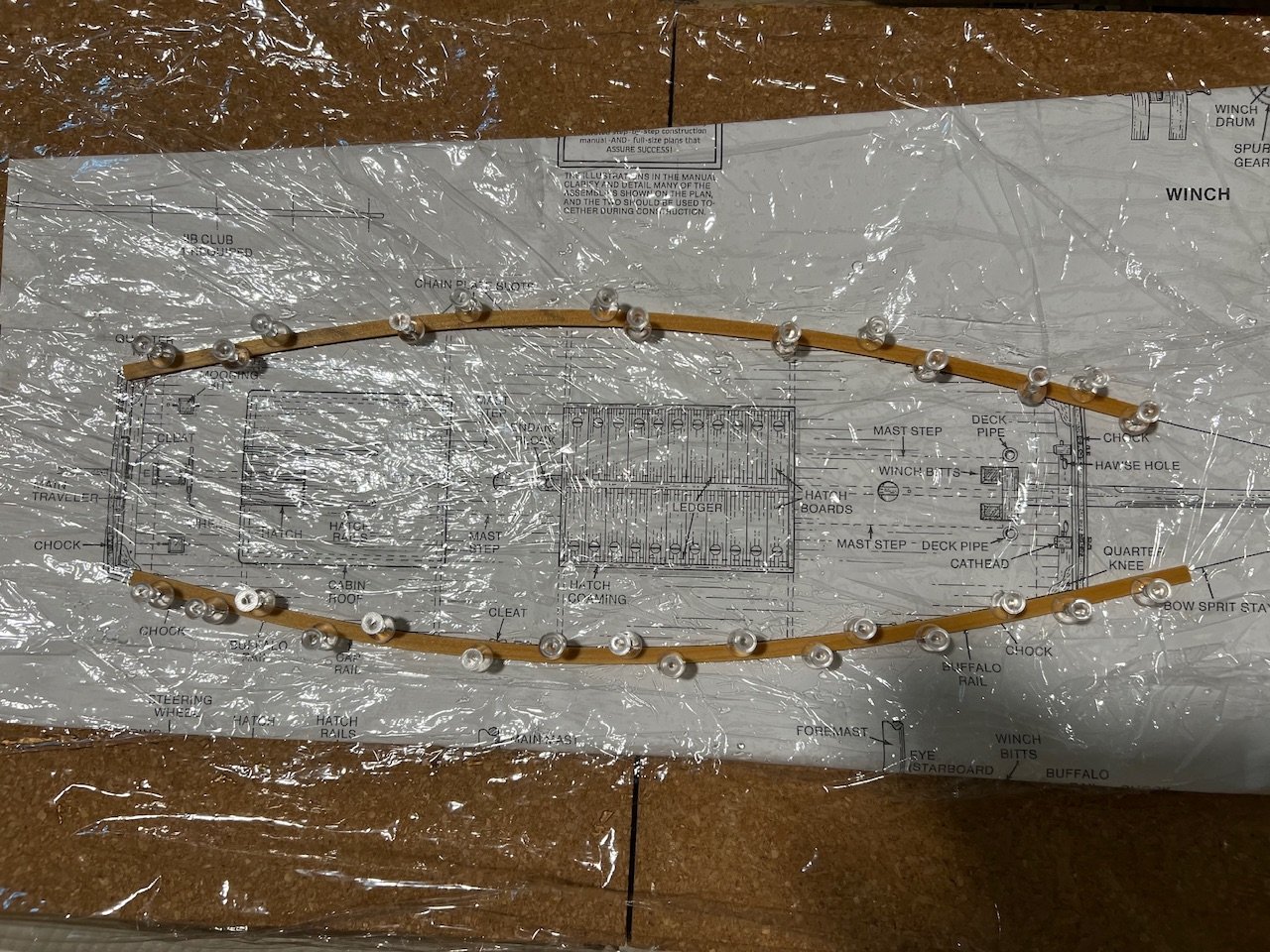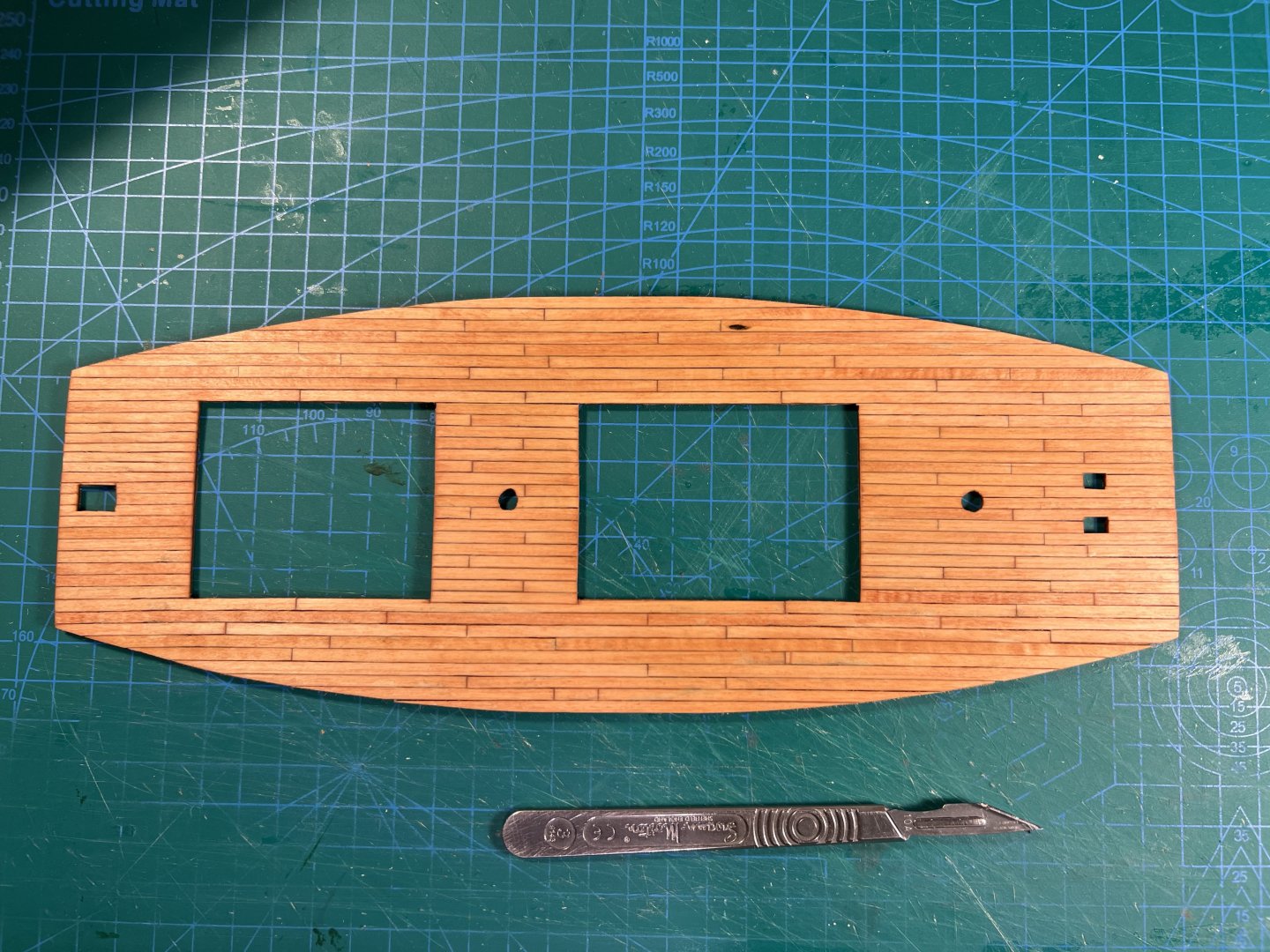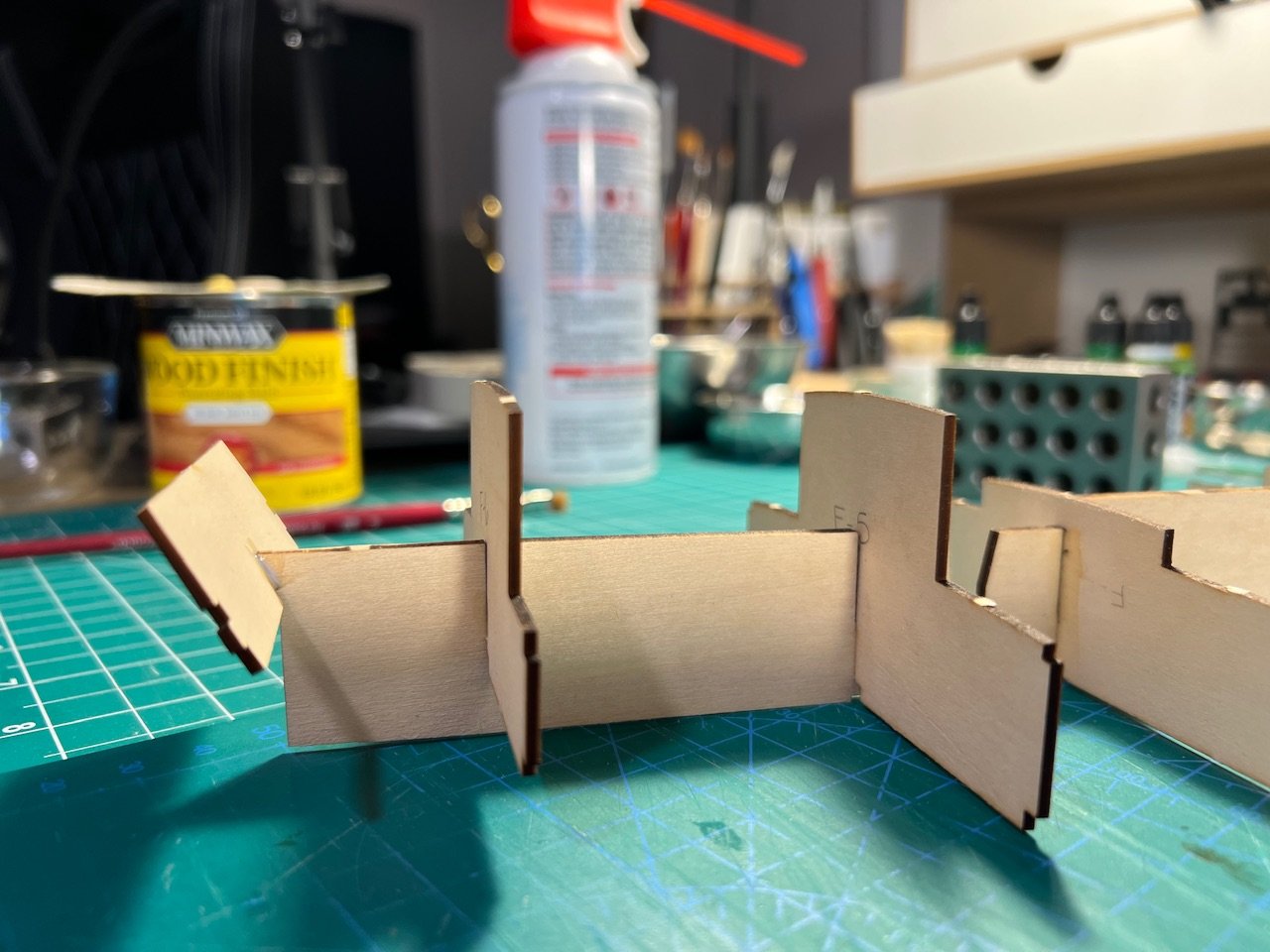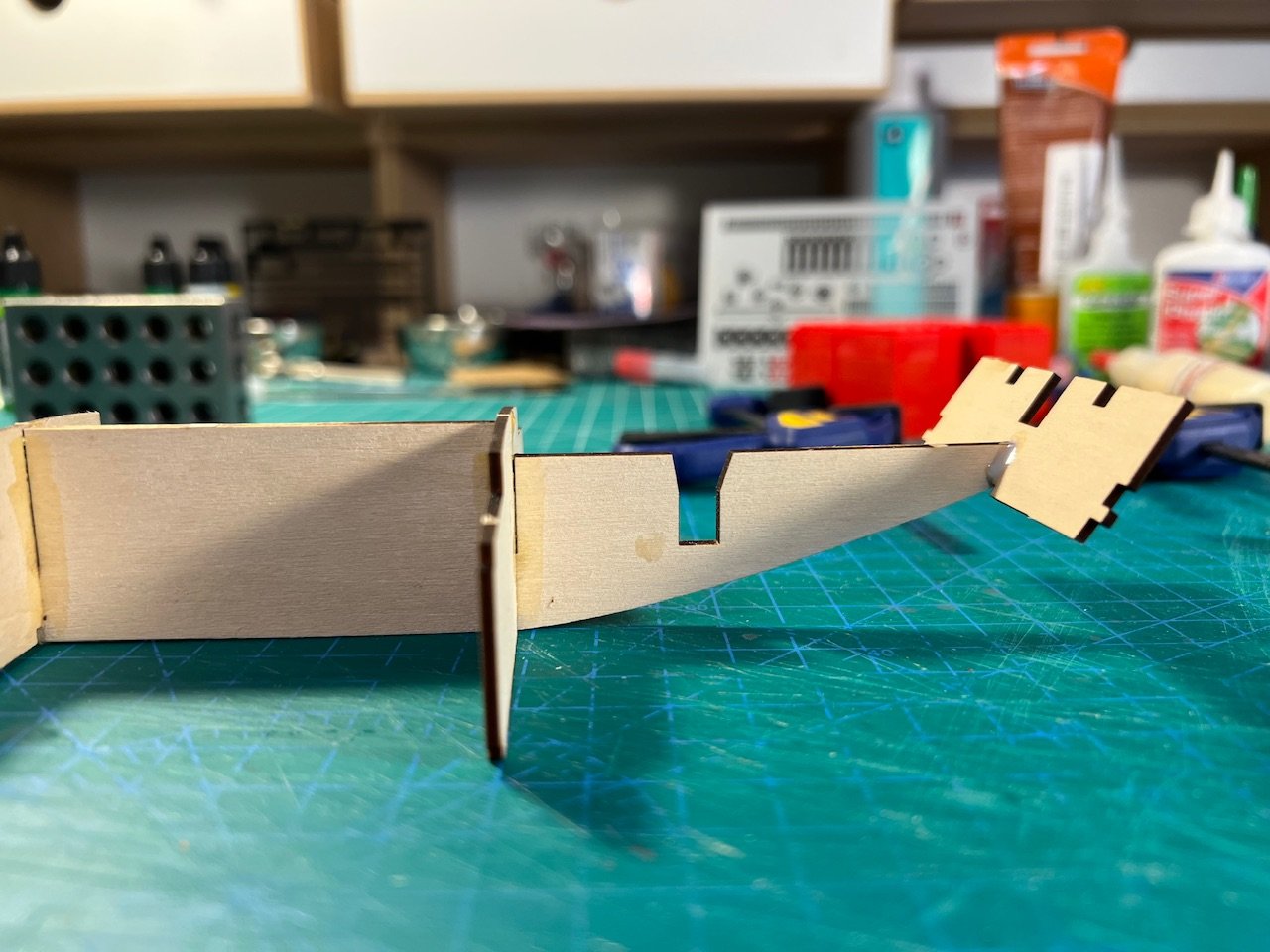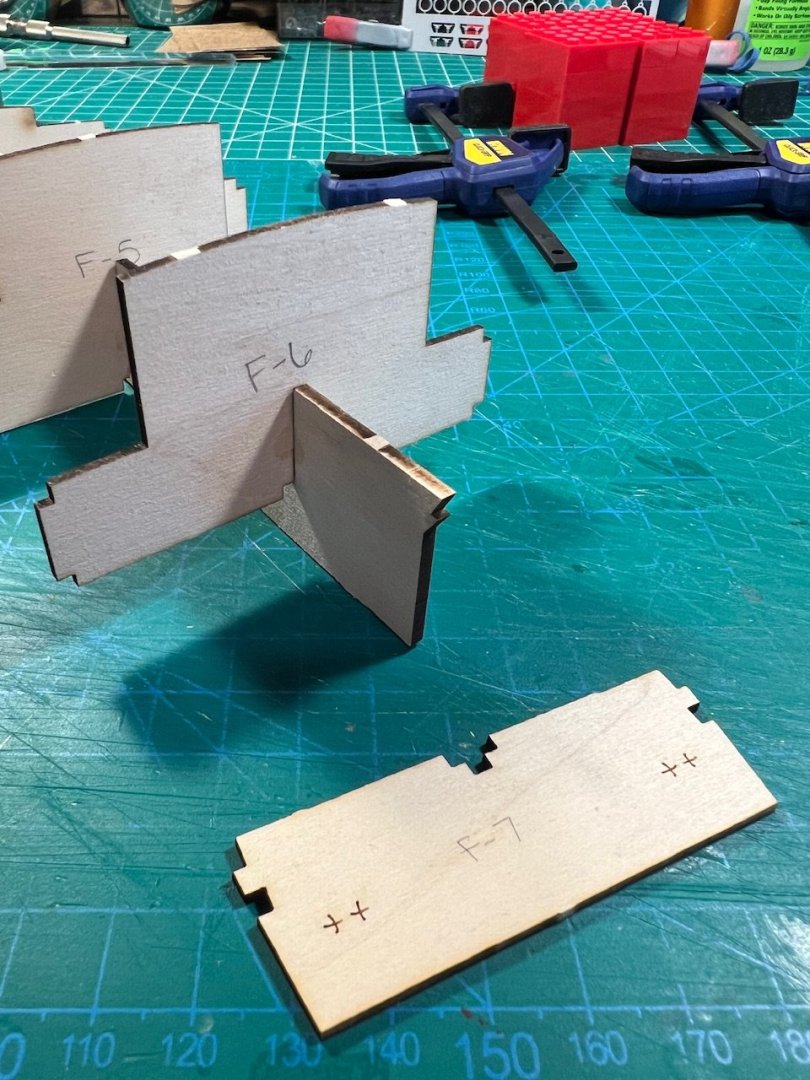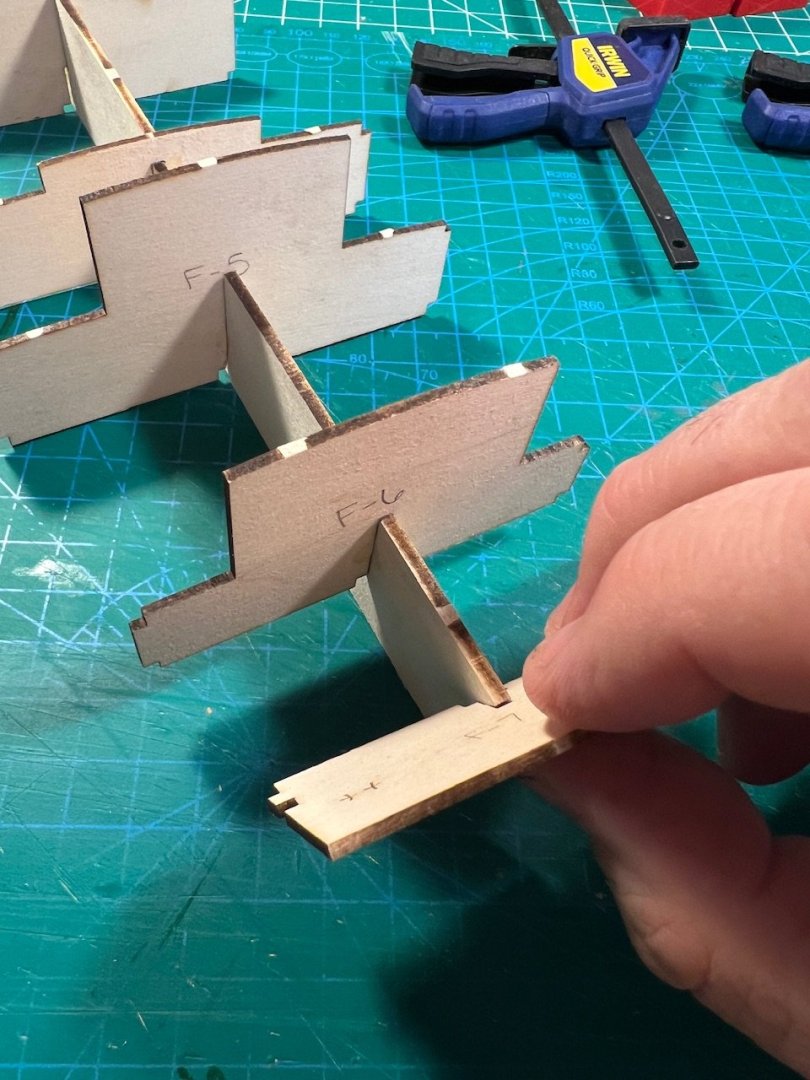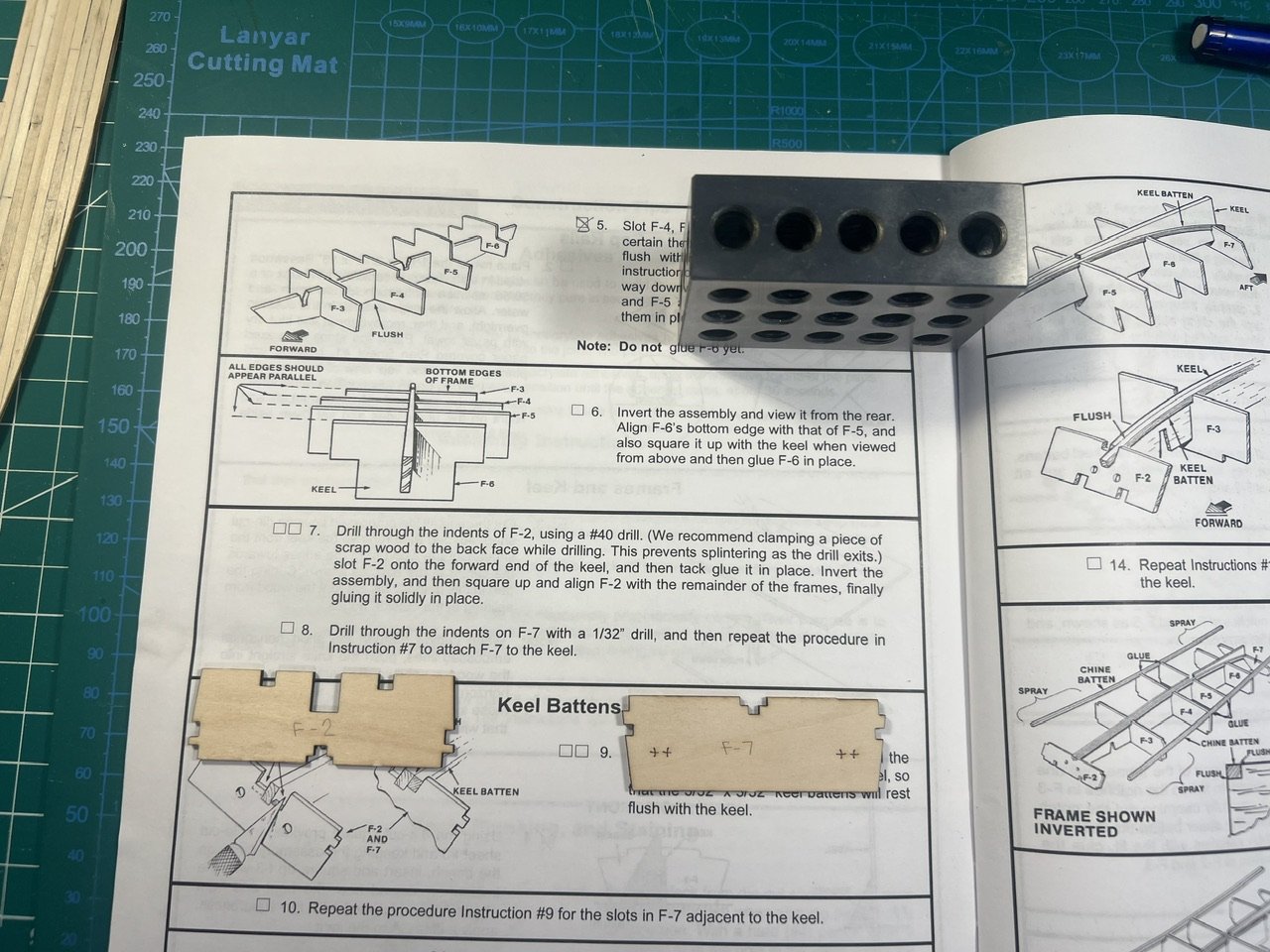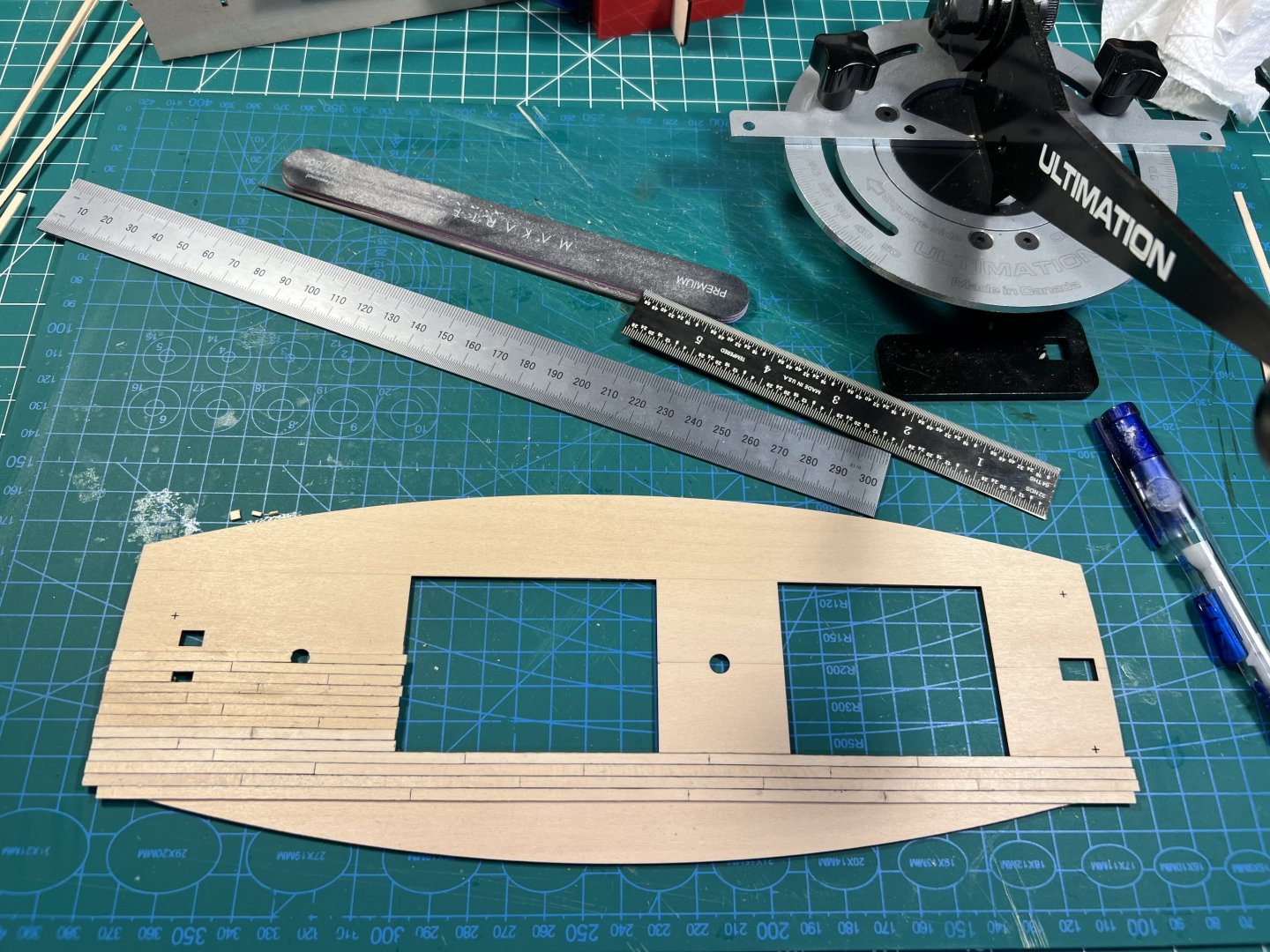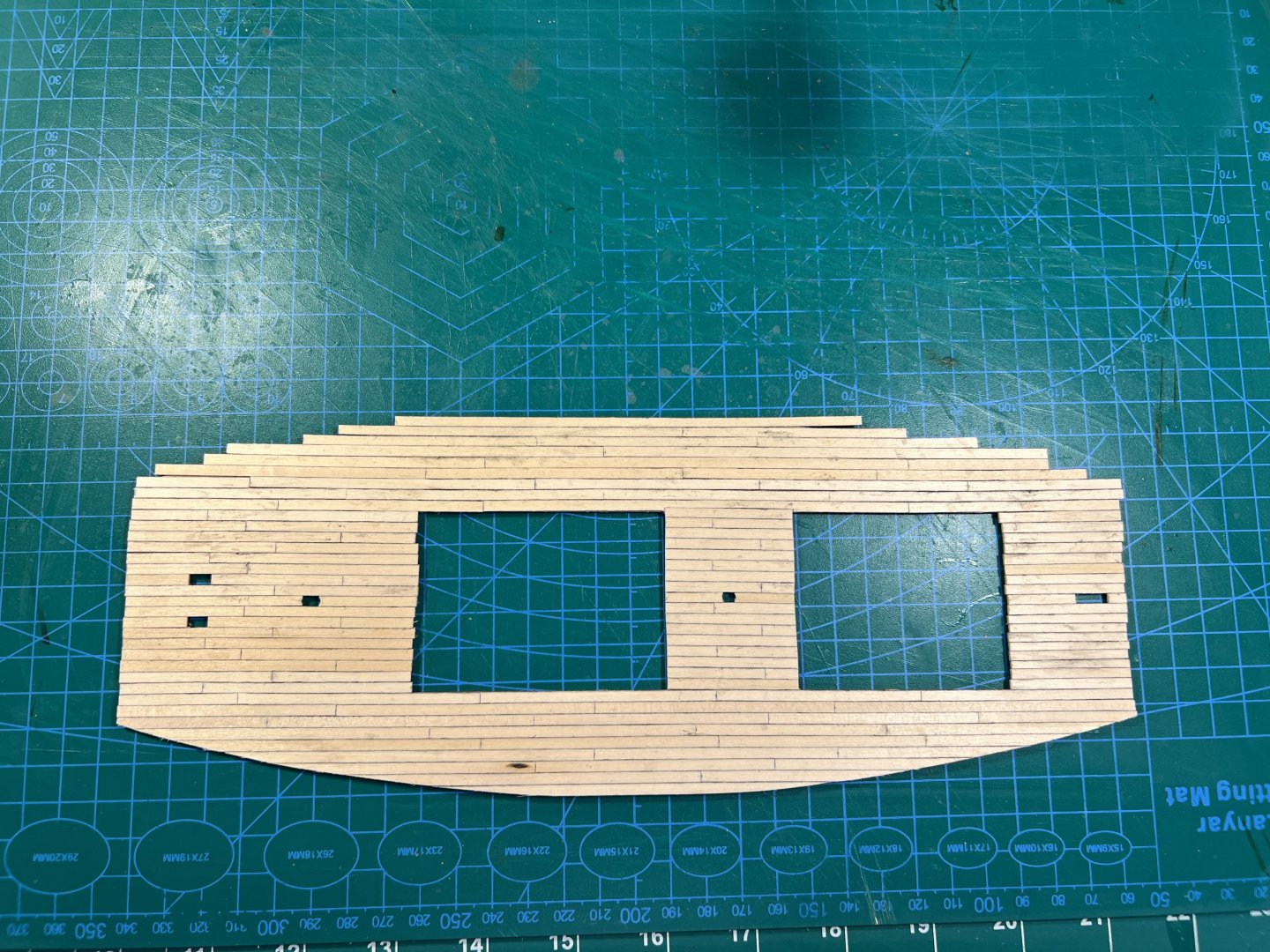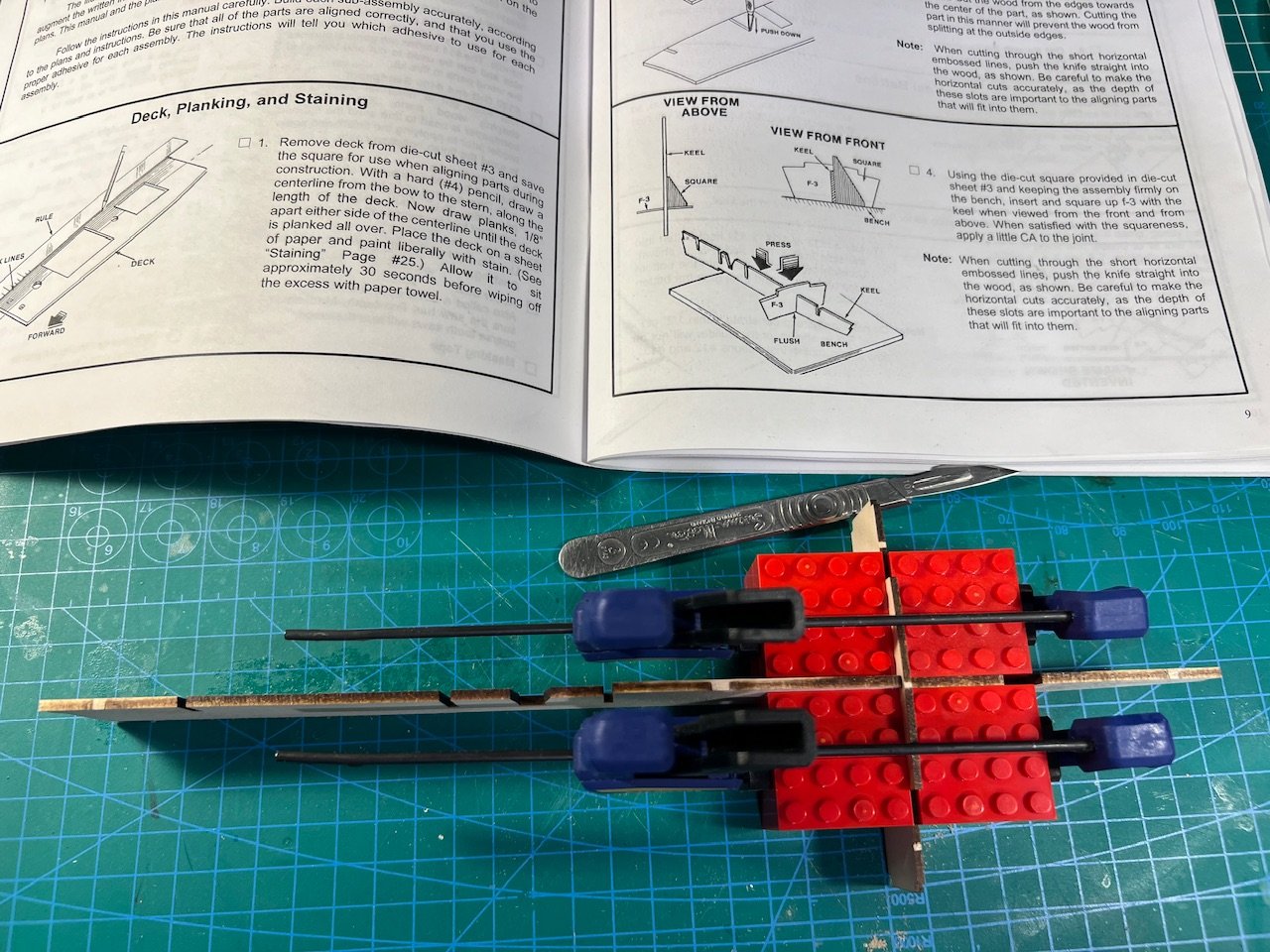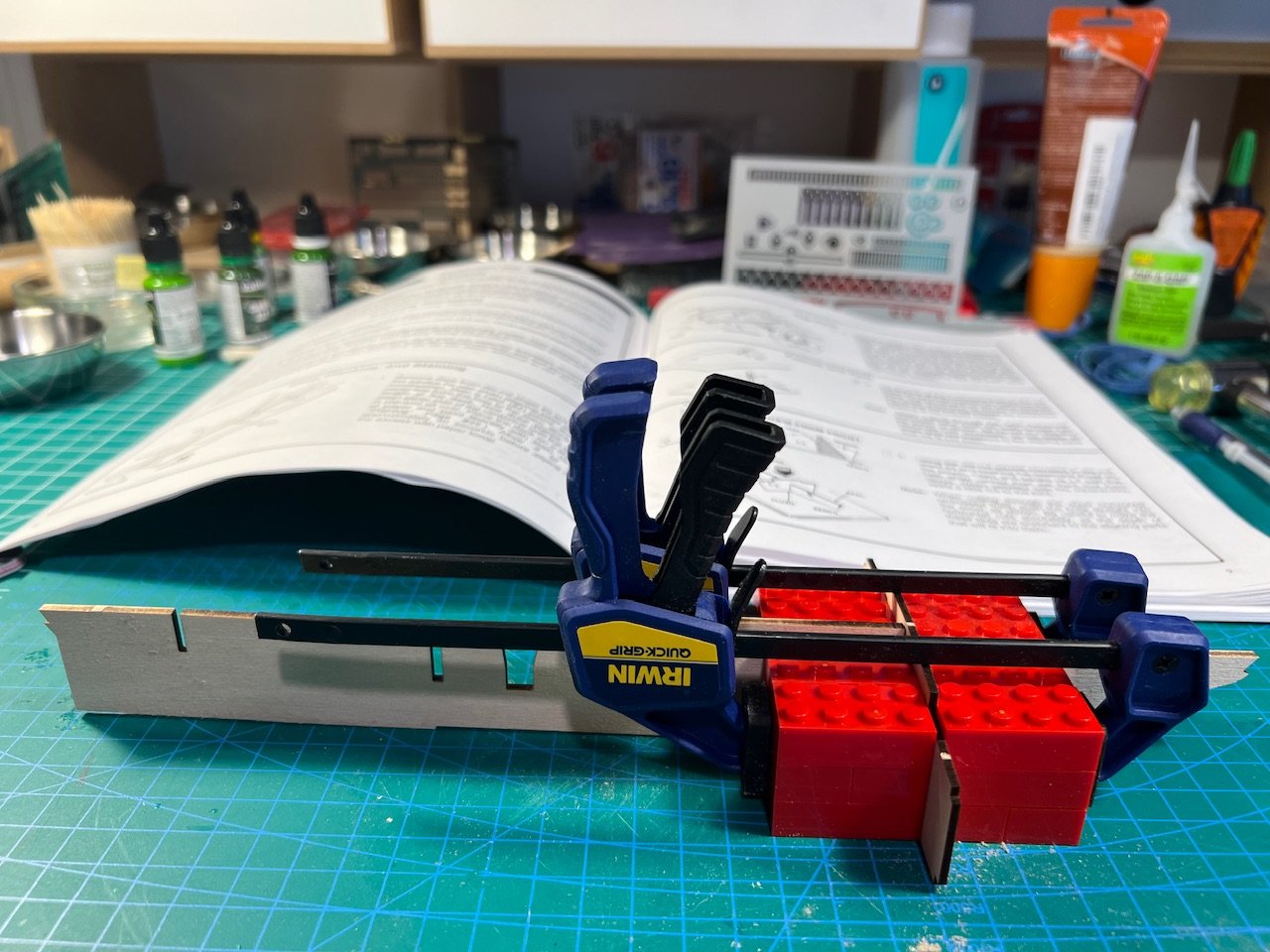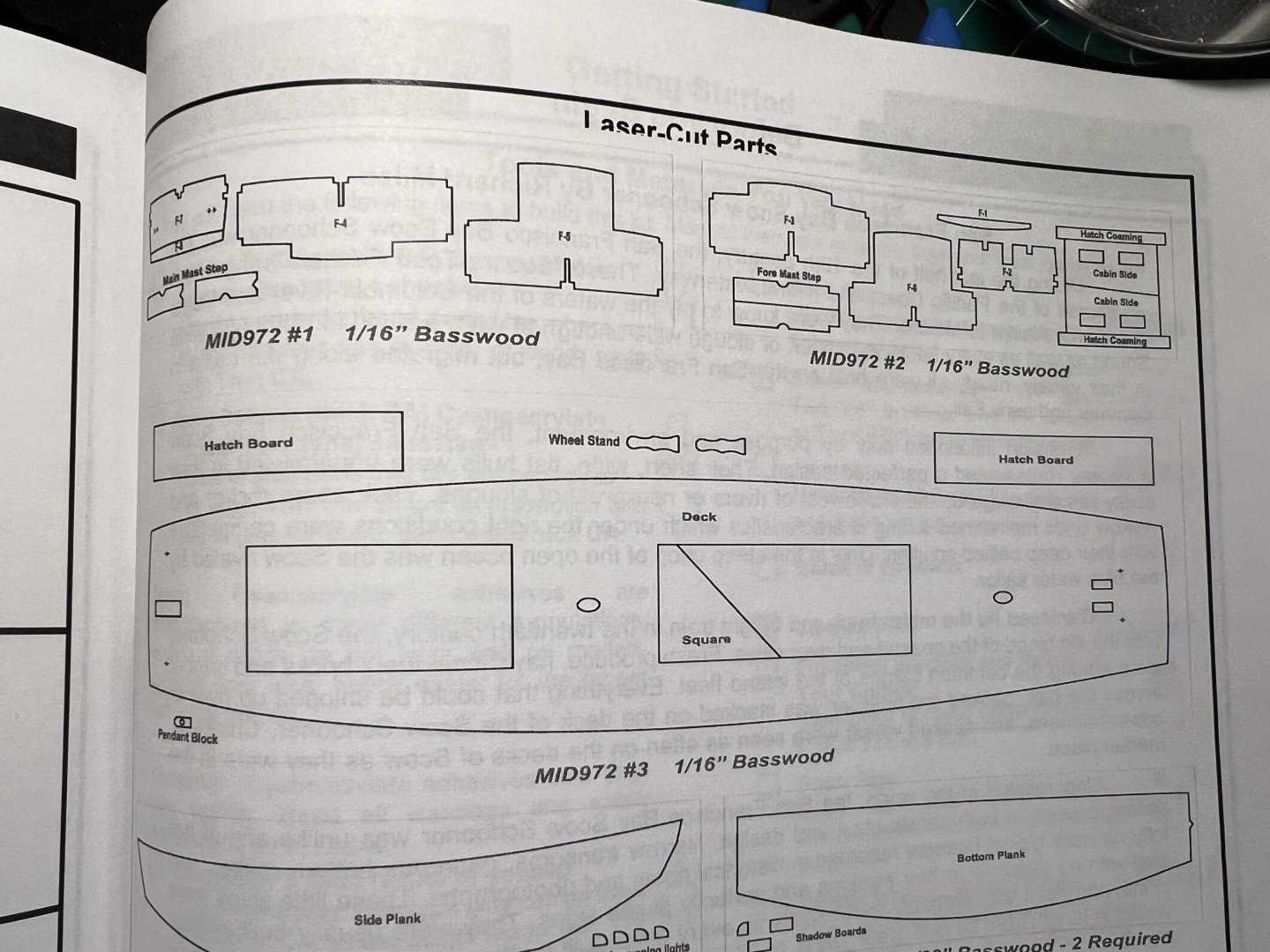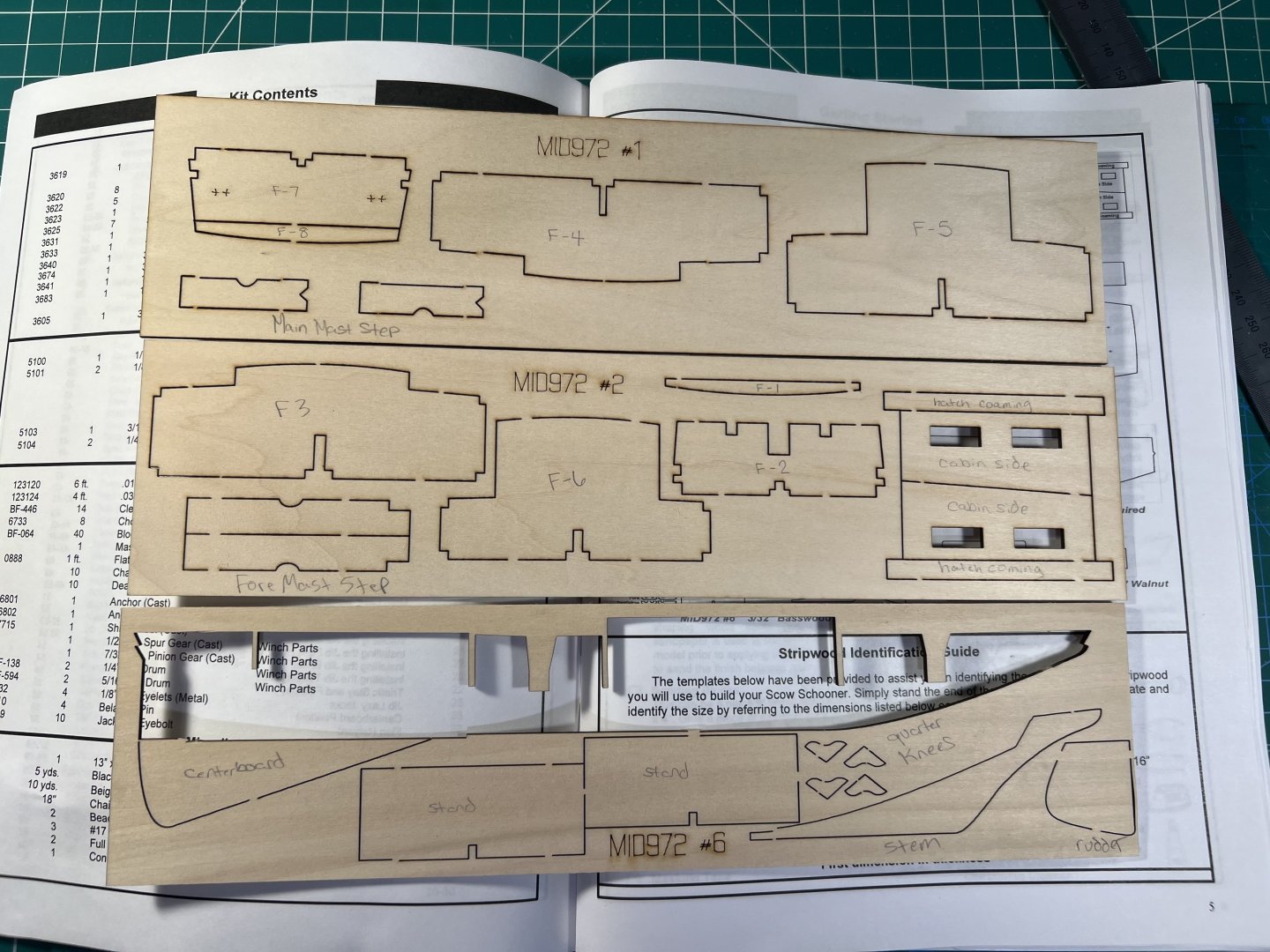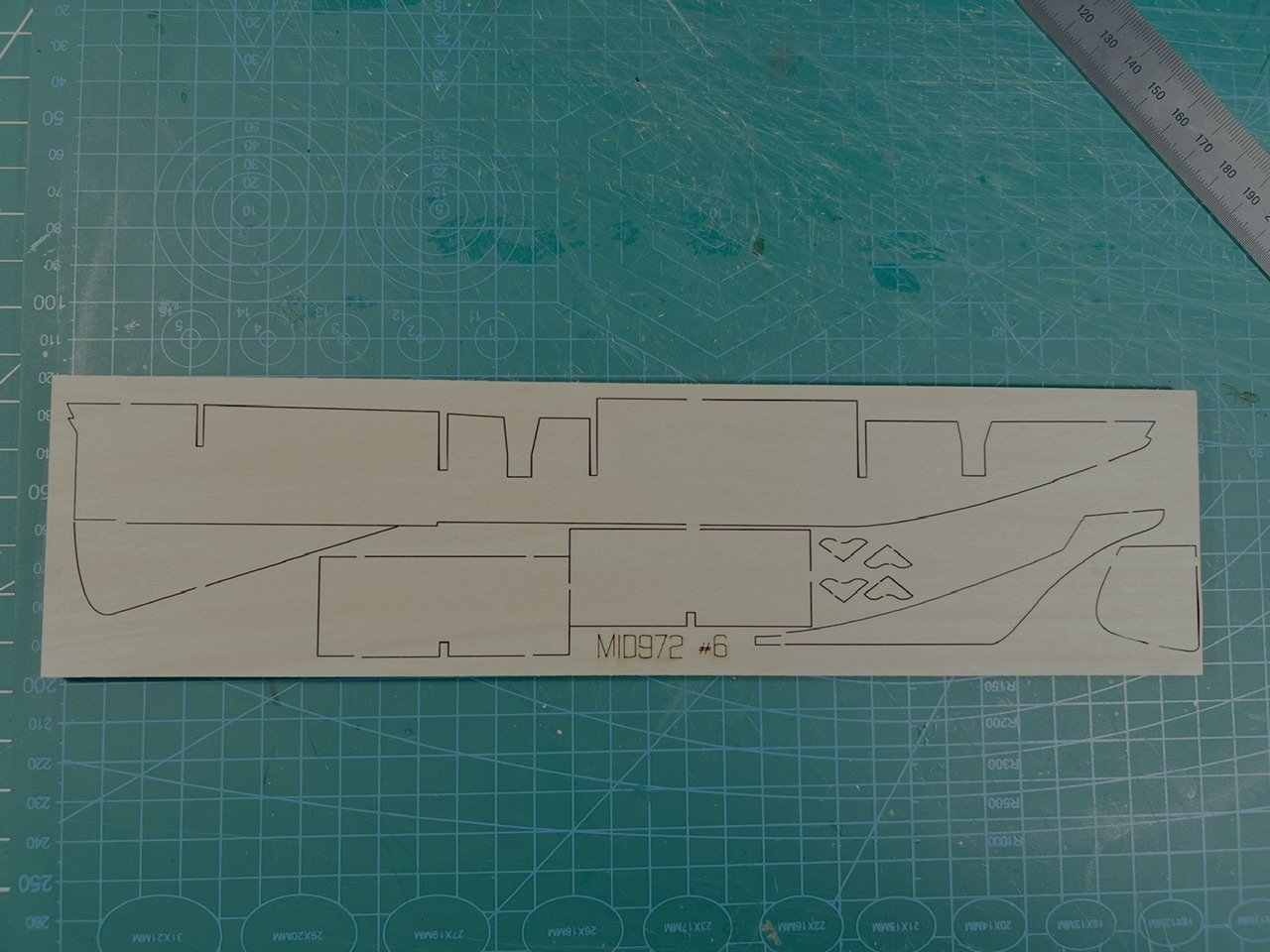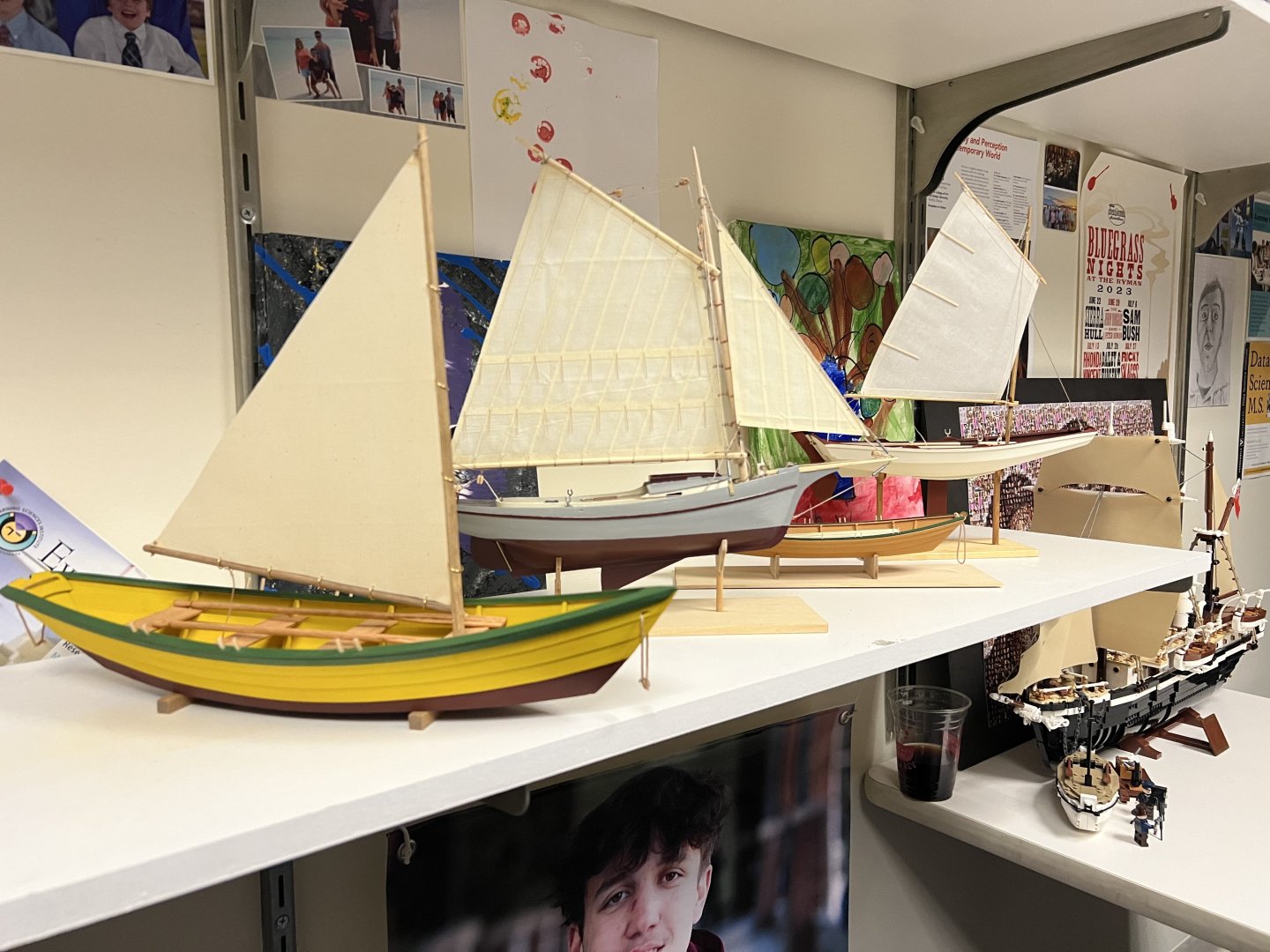
palmerit
NRG Member-
Posts
999 -
Joined
-
Last visited
Content Type
Profiles
Forums
Gallery
Events
Everything posted by palmerit
-
I’ve got a bunch of touching up to do but the hull painting is getting closer to being complete. After touching up I’ll add a few coats of matte varnish, let it dry for a couple days and the wrap the hull up to prevent it from getting dinged and scratched.
- 133 replies
-
- Ranger
- vanguard models
-
(and 1 more)
Tagged with:
-
- 37 replies
-
- San Francisco Bay Scow Schooner
- Scow Scooner
-
(and 1 more)
Tagged with:
-
Tried out some reds for the bottom of the hull. I think I’m going to go with 1/2 Vallejo Model Air Red 71.102 and 1/2 Vallejo Model Air German Red Briwn 71.271. The instructions use a PlastiKote Red Primer. Trying to approximate a red oxide color.
- 133 replies
-
- Ranger
- vanguard models
-
(and 1 more)
Tagged with:
-
pin vise and drill bits
palmerit replied to palmerit's topic in Modeling tools and Workshop Equipment
I grew up outside of Buffalo and went over to the Niagara Falls, Ontario store when I was up there in the winter. Thankfully, they didn’t have a lot of their miniature tools in stock. -
pin vise and drill bits
palmerit replied to palmerit's topic in Modeling tools and Workshop Equipment
I ended up buying the Starrett set of four pin vises from Lee Valley. I only had a need to use one of them once so far but it was night and day compared to the cheap pin vise I had to use before. It locked down tight and the drill bit did not shift. I'll report back if they don't live up to the price tag. I was getting frustrated with my old one and losing that frustration is worth it for me so far. Sadly, I ended up browsing while on the Lee Valley website and some uncontrollable compulsion led me to buy this mini workbench and mini workbench accessory set: https://www.leevalley.com/en-us/shop/tools/hand-tools/miniature-tools/113770-veritas-miniature-worksurface https://www.leevalley.com/en-us/shop/tools/hand-tools/miniature-tools/113771-veritas-miniature-workbench-accessories-set I'll do a different post if it turns out useful. -
Shaping the battens along the keel and side. This boat has fairly straight bottom and sides (not planks). It’s flat bottomed and fairly boxy. These battens provide the structure the hold the sides. The instructions say to just glue part and then bend using windex. I instead soaked in hot water for a bit. I just have them clamped in place to dry. I’ll glue them in place after they’ve dried to their shape. I’ll need to still add sheer battens along the stop. The two I installed are what the bottom pieces of the boat are glued to. The sheer battens (and chine batten) are what the sides are glued to. Very different construction from anything I’ve built so far.
- 37 replies
-
- San Francisco Bay Scow Schooner
- Scow Scooner
-
(and 1 more)
Tagged with:
-
Thanks for the clarification. The NPS site said "The last of her kind ..." Does "San Francisco Bay" scow schooner just refer to where they plied their trade or did it also refer to the class of boat (style, size, function).
- 37 replies
-
- San Francisco Bay Scow Schooner
- Scow Scooner
-
(and 1 more)
Tagged with:
-
Here's the link to the Alma, which is apparently the last survivor of this class of boats: https://www.nps.gov/safr/learn/historyculture/alma.htm https://www.nps.gov/media/photo/gallery.htm?id=3D3F9A47-D4DE-3CE6-089EB6E5DB6376B6
- 37 replies
-
- San Francisco Bay Scow Schooner
- Scow Scooner
-
(and 1 more)
Tagged with:
-
Winchelsea and other Syren ships are on my future list. And really they are. But I have a growing collection of models I bought that are sitting on my shelves. I've found doing smaller models with fewer repetitive steps has given me some good experience with different kinds of modeling steps. And since each model is not as expensive or as involved as something like the Winchelsea, if I made a mistake I can just trash the model or use the fix as a learning experience and then move to the next model. For example, I did the NRG Half Hull, which was a great experience, and it has a secondary home now on the top shelf of a book shelf in my office as opposed to the "place of honor" my other models are living in because it didn't turn out as nice as I had hoped. My learning experiences are clearly visible. Only the final models I really like are going to be centerpieces in our home. I find that the smaller models give me a chance to try different things since there is still so much I'm learning. I did my first deck planking on the Scow Schooner I'm working on. Some aspects of it I liked, others I didn't. But I learned something. I might have been more upset with the outcome if it was the deck of a ship that cost me lots of money and 1/2 year or more to get to the deck planking step and I screwed something up. But I have seen some people have successfully tackled a larger model and loved it soon into building these kits.
-
The 1:1 plans only show side view, top view, and sail. I’ll study some more. Perspective drawings show the holes so I could approximate but I don’t want to end up getting them in the wrong position if they need to be more precisely placed.
- 37 replies
-
- San Francisco Bay Scow Schooner
- Scow Scooner
-
(and 1 more)
Tagged with:
-
- 133 replies
-
- Ranger
- vanguard models
-
(and 1 more)
Tagged with:
-
Bending the rail. The instructions called for soaking the wood overnight in an ammonia/water solution. I just soaked them for an hour in water I got boiling and poured onto a cake pan. I laid the plans on a double layer of cork board, put Saran Wrap over top, and pinned to the shape on the plans. I’ll let them dry at least overnight.
- 37 replies
-
- San Francisco Bay Scow Schooner
- Scow Scooner
-
(and 1 more)
Tagged with:
-
- 37 replies
-
- San Francisco Bay Scow Schooner
- Scow Scooner
-
(and 1 more)
Tagged with:
-
I used Super Phatic glue, which cures fairly quickly compared to PVA but not as quickly as CA. It let me set the pieces and then adjust a bit before the glue cures fully. Hoping I got them aligned reasonably well. Definitely letting them dry overnight before continuing to the next steps.
- 37 replies
-
- San Francisco Bay Scow Schooner
- Scow Scooner
-
(and 1 more)
Tagged with:
-
The last pieces of the hull bulkheads are pretty challenging to attach. The point where they attach has just a tiny notch. No obvious way to make them aligned properly.
- 37 replies
-
- San Francisco Bay Scow Schooner
- Scow Scooner
-
(and 1 more)
Tagged with:
-
I found that someone scratch built a scow schooner - not a build log, but there are some photos I can reference:
- 37 replies
-
- San Francisco Bay Scow Schooner
- Scow Scooner
-
(and 1 more)
Tagged with:
-
I’m kind of stumped. The instructions say to drill through the indents of F-2. Don’t know what an “indent” is and there’s no mark showing where to drill. Says to do the same for F-7 and in this case there are two plus marks on either side. The illustration shows two holes but they are closer to the middle than the marks. Argh. Maybe I’ll wait until later in the build to figure out where the holes should none and drill them then.
- 37 replies
-
- San Francisco Bay Scow Schooner
- Scow Scooner
-
(and 1 more)
Tagged with:
-
I'm jumping back on my post from before about paint to ask about staining (thought rather than create a new thread, someone might find this useful discussion as applied to paints and stains). I'm working on my first deck planking for the Scow Schooner I'm building and plan to stain it. I have a bunch of 8oz stains and I'll be experimenting to see which looks better on some scrap wood. 1. The first step will be sanding the deck with some fine grit sandpaper. 2. Then I'll apply the stain. I know stain needs to be applied before adding any kind of shellac or poly. Is it better to apply with a brush and then wipe it down with a rag or apply with a rag? Or doesn't it really matter? Is the number of coats of stain just a matter of how dark I want it? With my airbrush I always need to apply at least 2-3 coats, sometimes more. I don't know if the same applies to stain, where 2 coats is a minimum, more is for a darker stain. I know I can experiment. I just wanted to see if there was accepted wisdom. 3. Should I apply sanding sealer after staining? Or shellac? I think sanding sealer and shellac serve the same purpose, right? I have both. And then sand again with fine sandpaper? Then another application of sanding sealer or shellac after the first sanding? I'm guessing I could do a 0000 steel wool pass after the 2nd sanding (I have a magnet to pick up steel wool fuzz). Does that sound right? The wood is pretty soft and has a bit of a fuzz. 4. I will be attaching deck furniture and houses, so I may need to be able to glue things to the deck. My understanding is that PVA can cure like normal when applied to a stained piece of wood otherwise untreated. Would the same be true if it had sanding sealer or shellac? Would CA glue be a better bet? Is there a concern here that the glue is gluing the piece to the layer of shellac? 5. The matte varnish I have is acrylic (Vallejo). I'm guessing I should not spray on an acrylic varnish on top of sanding sealer or shellac (like I would on top of acrylic paint).
-
My first deck planking. After it dries I’ll trim the edges and cutouts, do a light sanding, and add some stain. I used the usual (standard) approach of running pencil lead along one edge (both one long edge and one shallow edge). From everything I've read, a dark sharpie or other marker is too dark and the ink bleeds and is not subtle enough for a ship of this scale. I've seen some people recommend India ink. But I think the pencil let works well. It's what I used on the NRG Half Hull. It's good to get in a rhythm with this. I think I only forgot to pencil the short edge between board a couple of times. I wasn't quite sure how to stagger the deck boards and whether they should be random or follow a rough pattern. I think next time I'll try to research the best ways to do this and mock out some possible patterns (or try to just do them entirely random). Note sure I quite like how the pattern turned out. I think I have blunt ends too close to one another in a few spots because I didn't fully plan ahead. I was trying to keep in mind what I learned by doing the NRG Half Hull, but keeping in mind didn't quite turn into execution. I should have created a pattern beforehand. I also wasn't quite sure what to do on the short sections in the middle of the hull. In the middle I had some planks butting together. In the rear end I had them all as full pieces. I wanted to see how the two options looked.
- 37 replies
-
- San Francisco Bay Scow Schooner
- Scow Scooner
-
(and 1 more)
Tagged with:
-
Slow assembly of the frame. So different from a Vanguard model. Need to align and clamp every individual frame piece. Glad I bought a set of 100 of these Lego-like pieces on Amazon a while back.
- 37 replies
-
- San Francisco Bay Scow Schooner
- Scow Scooner
-
(and 1 more)
Tagged with:
-
Need to write the part numbers on the sheets, following the layout map on a page at the start of the instructions.
- 37 replies
-
- San Francisco Bay Scow Schooner
- Scow Scooner
-
(and 1 more)
Tagged with:
-
- 37 replies
-
- San Francisco Bay Scow Schooner
- Scow Scooner
-
(and 1 more)
Tagged with:
-
- 71 replies
-
- grand banks dory
- midwest products
-
(and 2 more)
Tagged with:
About us
Modelshipworld - Advancing Ship Modeling through Research
SSL Secured
Your security is important for us so this Website is SSL-Secured
NRG Mailing Address
Nautical Research Guild
237 South Lincoln Street
Westmont IL, 60559-1917
Model Ship World ® and the MSW logo are Registered Trademarks, and belong to the Nautical Research Guild (United States Patent and Trademark Office: No. 6,929,264 & No. 6,929,274, registered Dec. 20, 2022)
Helpful Links
About the NRG
If you enjoy building ship models that are historically accurate as well as beautiful, then The Nautical Research Guild (NRG) is just right for you.
The Guild is a non-profit educational organization whose mission is to “Advance Ship Modeling Through Research”. We provide support to our members in their efforts to raise the quality of their model ships.
The Nautical Research Guild has published our world-renowned quarterly magazine, The Nautical Research Journal, since 1955. The pages of the Journal are full of articles by accomplished ship modelers who show you how they create those exquisite details on their models, and by maritime historians who show you the correct details to build. The Journal is available in both print and digital editions. Go to the NRG web site (www.thenrg.org) to download a complimentary digital copy of the Journal. The NRG also publishes plan sets, books and compilations of back issues of the Journal and the former Ships in Scale and Model Ship Builder magazines.

